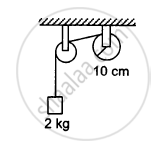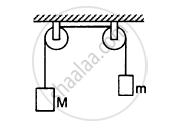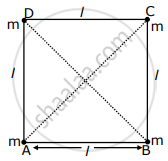Advertisements
Advertisements
प्रश्न
A solid cylinder rolls up an inclined plane of angle of inclination 30°. At the bottom of the inclined plane, the centre of mass of the cylinder has a speed of 5 m/s.
(a) How far will the cylinder go up the plane?
(b) How long will it take to return to the bottom?
उत्तर १
Here, θ= 30°, v = 5 m/ s
Let the cylinder go up the plane up to a height h.
From 1/2 mv2 +1/2IW2 = mgh
`1/2 mv^2 + 1/2(1/2mr^2)omega^2 = mgh`
`3/4mv^2 = mgh`
`h = (3v^2)/(4g) = (3xx5^2)/(4xx9.8) = 1.913 m`
if s is the distance up the inclined plane, then as
`sin theta = h/s, s = h/(sin theta) = 1.913/sin 30^@ 3.856 m`
Time taken to return to the bottom
`t = sqrt((2s(1+k^2/r^2))/(g sin theta)) = sqrt((2xx 3826(1+1/2))/(9.8 sin 30^@)) = 1.53s`
उत्तर २
A solid cylinder rolling up an inclination is shown in the following figure.

Initial velocity of the solid cylinder, v = 5 m/s
Angle of inclination, θ = 30°
Height reached by the cylinder = h
(a) Energy of the cylinder at point A:
`KE_"rot" = KE_"trans"`
`1/2 Iomega^2 = 1/2 mv^2`
Energy of the cylinder at point B = mgh
Using the law of conservation of energy, we can write:
`1/2Iomega^2 = 1/2mv^2 = mgh`
Moment of inertia of the solid cylinder, `I = 1/2 mr^2`
`:.1/2(1/2 mr^2)omega^2 + 1/2 mv^2 = mgh`
`1/4 mr^2 omega^2 + 1/2 mv^2 = mgh`
But we have the relation `v = romega`
`:.1/4v^2 + 1/2v^2 = gh`
`3/4 v^2 =gh`
`:.h = 3/4 v^2/g`
`= 3/4 xx (5xx5)/(9.8) = 1.91 m`
In `triangleABC`
`sin theta = (BC)/(AB)`
`sin 30^@ = h/(AB)`
`AB = (1.91)/0.5 = 3.82 m`
Hence, the cylinder will travel 3.82 m up the inclined plane.
(b) For radius of gyration K, the velocity of the cylinder at the instance when it rolls back to the bottom is given by the relation:
`v = ((2gh)/(1+K^2/R^2))^(1/2)`
`:.v = ((2gABsin theta)/(1+K^2/R^2))^(1/2)`
For the soild cylinder, `K^2 = R^2/2`
`:.v = ((2gABsin theta)/(1+1/2))^(1/2)`
`= (4/3gABsin theta)^(1/2)`
The time taken to return to the bottom is:
`t = (AB)/v`
`= (AB)/(4/3gABsintheta)^(1/2) =((3AB)/(4gsintheta))^"1/2"`
`=(11.46/19.6)^(1/2) = 0.764 s`
Therefore, the total time taken by the cylinder to return to the bottom is (2 × 0.764) 1.53 s.
APPEARS IN
संबंधित प्रश्न
Show that the child’s new kinetic energy of rotation is more than the initial kinetic energy of rotation. How do you account for this increase in kinetic energy?
A rope of negligible mass is wound round a hollow cylinder of mass 3 kg and radius 40 cm. What is the angular acceleration of the cylinder if the rope is pulled with a force of 30 N? What is the linear acceleration of the rope? Assume that there is no slipping.
Two discs of moments of inertia I1 and I2 about their respective axes (normal to the disc and passing through the centre), and rotating with angular speeds ω1 and ω2 are brought into contact face to face with their axes of rotation coincident. (a) What is the angular speed of the two-disc system? (b) Show that the kinetic energy of the combined system is less than the sum of the initial kinetic energies of the two discs. How do you account for this loss in energy? Take ω1 ≠ ω2.
A string is wrapped on a wheel of moment of inertia 0⋅20 kg-m2 and radius 10 cm and goes through a light pulley to support a block of mass 2⋅0 kg as shown in the following figure. Find the acceleration of the block.

The pulleys shown in the following figure are identical, each having a radius R and moment of inertia I. Find the acceleration of the block M.

The descending pulley shown in the following figure has a radius 20 cm and moment of inertia 0⋅20 kg-m2. The fixed pulley is light and the horizontal plane frictionless. Find the acceleration of the block if its mass is 1⋅0 kg.

From a circular ring of mass, ‘M’ and radius ‘R’ an arc corresponding to a 90° sector is removed. The moment of inertia of the remaining part of the ring about an axis passing through the centre of the ring and perpendicular to the plane of the ring is ‘K’ times ‘MR2’. Then the value of ‘K’ is ______.
Moment of inertia (M.I.) of four bodies, having same mass and radius, are reported as :
I1 = M.I. of thin circular ring about its diameter,
I2 = M.I. of circular disc about an axis perpendicular to disc and going through the centre,
I3 = M.I. of solid cylinder about its axis and
I4 = M.I. of solid sphere about its diameter.
Then -
Four equal masses, m each are placed at the corners of a square of length (l) as shown in the figure. The moment of inertia of the system about an axis passing through A and parallel to DB would be ______.

A cubical block of mass 6 kg and side 16.1 cm is placed on a frictionless horizontal surface. It is hit by a cue at the top to impart impulse in the horizontal direction. The minimum impulse imparted to topple the block must be greater than ______ kg m/s.
